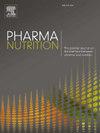Functional food prevents diabetic nephropathy in a rat model through inhibition of aldose reductase and accumulation of advanced glycation end-products
IF 2.4
Q3 NUTRITION & DIETETICS
引用次数: 0
Abstract
Diabetic nephropathy (DN) is a chronic microvascular complication of diabetes mellitus, characterized by glomerulomegaly, podocytopathy, and proteinuria. Among the many molecular mechanisms, accumulation of advanced glycation end-products (AGEs) due to non-enzymatic glycation and sorbitol accumulation due to increased aldose reductase (AR) activity are implicated in DN. We previously identified some functional foods and their bioactive molecules for inhibitory potential against AGE formation and, AR activity. Based on those studies, in this study, we formulated a functional food (FF) mix- composed of amla, turmeric, cinnamon, ginger, and black pepper in a specific proportion and tested its efficacy against DN in a rat model. Two-month-old Sprague Dawley rats were grouped into control (C), streptozotocin-induced diabetes (D), and diabetes treated with FF at two doses (FF1–0.85 g and FF2–4.25 g/ 100 g diet). The animals were maintained for 20 weeks on respective diets after the induction of diabetes. Elevated serum albumin, creatinine, and urea were observed in the untreated diabetic group compared to the control. These changes were significantly ameliorated by FF supplementation. FF2 showed better efficacy than FF1 in preventing proteinuria, as reflected in the albumin and creatinine ratio. Further, FF prevented diabetes induced AGE accumulation, inflammation, and activation of the polyol pathway in the kidney. The FF decreased the expression of TGF-β in the diabetic kidney and prevented fibrotic changes. Most importantly, FF prevented the depletion of podocyte slit diaphragm proteins and histological changes. These results provide a mechanistic basis of FF and its potential against progression of DN in a rat model.
功能性食物通过抑制醛糖还原酶和晚期糖基化终产物的积累来预防大鼠模型中的糖尿病肾病
糖尿病肾病(DN)是糖尿病的一种慢性微血管并发症,以肾小球肿大、足细胞病和蛋白尿为特征。在许多分子机制中,非酶糖基化引起的晚期糖基化终产物(AGEs)的积累和醛糖还原酶(AR)活性增加引起的山梨醇积累与DN有关。我们之前已经确定了一些功能食品及其生物活性分子对AGE形成和AR活性的抑制潜力。在此基础上,本研究配制了一种由amla、姜黄、肉桂、生姜和黑胡椒按一定比例组成的功能食品(FF)混合物,并在大鼠模型上测试了其抗DN的功效。2月龄Sprague Dawley大鼠分为对照组(C)、链脲佐菌素诱导糖尿病组(D)和两种剂量FF (FF1-0.85 g和FF2-4.25 g/ 100 g日粮)治疗糖尿病组。诱导糖尿病后,各组分别饲喂不同的饲料,饲养20周。与对照组相比,未经治疗的糖尿病组血清白蛋白、肌酐和尿素升高。这些变化在补充FF后得到显著改善。FF2在预防蛋白尿方面的效果优于FF1,这可以从白蛋白和肌酐比值中体现出来。此外,FF还能预防糖尿病诱导的AGE积累、炎症和肾脏多元醇途径的激活。FF可降低糖尿病肾组织TGF-β的表达,防止纤维化改变。最重要的是,FF阻止足细胞狭缝膜蛋白的消耗和组织学改变。这些结果提供了FF的机制基础及其在大鼠模型中抗DN进展的潜力。
本文章由计算机程序翻译,如有差异,请以英文原文为准。
求助全文
约1分钟内获得全文
求助全文
来源期刊

PharmaNutrition
Agricultural and Biological Sciences-Food Science
CiteScore
5.70
自引率
3.10%
发文量
33
审稿时长
12 days
 求助内容:
求助内容: 应助结果提醒方式:
应助结果提醒方式:


